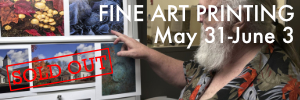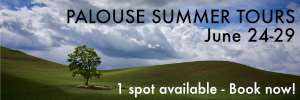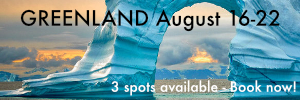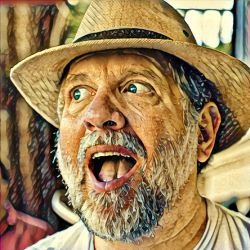Home > Page 4
John Sadowsky
Forum Replies Created
-
AuthorTopic: The Language of Art – Part 10 – Levels of Abstraction Read 0 Times
-
in reply to: CaptureOne Pro 21 is here! #30593CaptureOne Pro 21 is here!on: December 8, 2020 at 7:29 pm
I do like the ProStandard profile better. Not sure how to quantify it, but I’ve been using my own profile created with Lumariver.
My understanding is that Lumariver is like XRite ICC profiling on steroids. If you use a custom profile, then you wouldn’t be using the C1 provided Generic or ProStandard profiles – right? (After all, these are still all ICC standard profiles.) I understand that some photographers make custom profiles for different conditions (golden hour, daylight, cloudy, etc.) – do you do that? If so, I’d like to hear how ProStandard compares to a Lumariver custom profile tuned for different conditions.
I have an XRite Color Checker – but gave up on using custom profiles. I do landscape and I make a lot of color adjustments – so what’s the point? ProStandard may be all I need. I do, however, understand that custom profiles would be useful for product photography and studio work.
JSS
-
This reply was modified 3 years, 5 months ago by
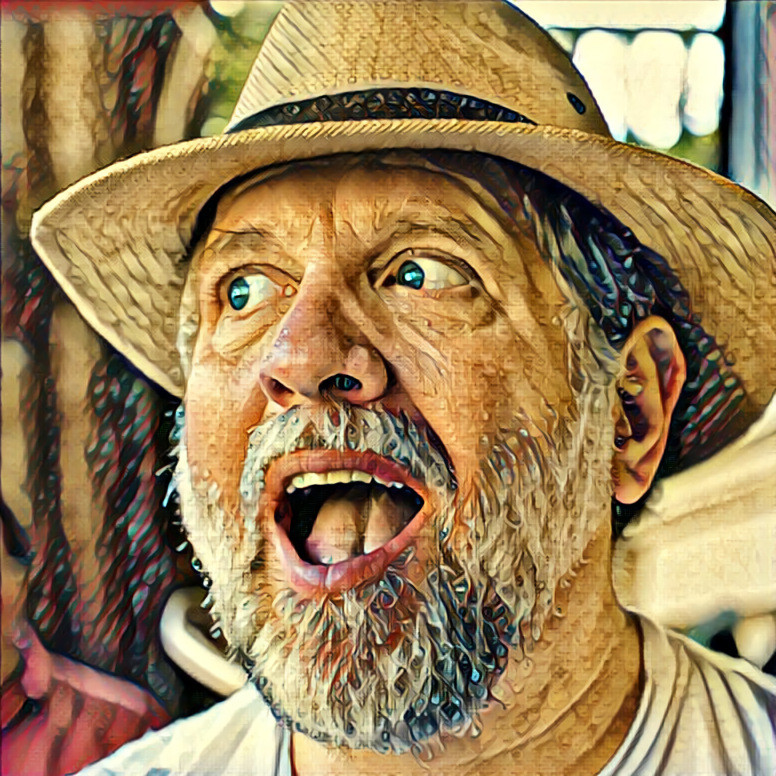 John Sadowsky.
John Sadowsky.
in reply to: Exposure Technique for Mirrorless using Zebras #30274Re: Exposure Technique for Mirrorless using ZebrasReply #1 on: December 6, 2020 at 5:36 pmAgreed, they are still likely based solely on the processed & downsampled EVF video feed.
I read the Sony and Wikipedia article – thanks. It’s definitely not the RAW exposure tool we really need – and that the camera manufacturers should provide. IRE seems to be an analog standard, but these things tend to get migrated into the digital domain whether it makes sense or not (e.g.: ISO). Regardless, it is based on the RBG EVF stream. Still, the method could be useful possibly in conjunction with the real-time histogram.
JSS
-
This reply was modified 3 years, 5 months ago by
 John Sadowsky.
John Sadowsky.
in reply to: Exposure Technique for Mirrorless using Zebras #30254Re: Exposure Technique for Mirrorless using ZebrasReply #2 on: December 6, 2020 at 2:31 pmThis is really interesting. It’s commonly believed that mirrorless live histograms/blinkies/zebras are based on the data from the camera’s highly downsampled and processed EVF video feed. This zebra trick implies, at least on Sony cameras, that these live zebra warnings are based on data from earlier in the EVF image processing pipeline, which is potentially huge news for raw shooters desiring real-time exposure warnings.
I can’t say where in the processing pipe where the zebra is thresholded – and Sony is not likely going to tell us. As has been discussed on the other thread, it would be nice if we had exposure tools based on RAW data. Since zebras are primarily videography, I suspect they too are calculated from EVF. In addition, we don’t know if the zebra is triggered when any one of the color channels clips, or is it a threshold on a brightness value derived from the RGB channels. Of course, we want the former, but we likely get the latter.
JSS
in reply to: Switching from Lightroom to Capture One Questions #30155Re: Switching from Lightroom to Capture One QuestionsReply #3 on: December 3, 2020 at 7:39 pmThings I missed from Lightroom
There is no doubt about it, Lr is a better library (database, asset management, etc.) program. Add to your list no face recognition keywording.
I also agree that the Lr print module is superior. The recipes are nice, but that’s largely a fancy user interface, and it’s not directly linked to printing. C1 doesn’t give us out-of-gamut warnings, and in “proofing” you have to select rendering intent via Preferences (WTF).
I’m not completely buying your “masking for sharpening” complaint. C1 provides a threshold slider for sharpening, which is what Lr does. The difference is that Lr provides a grayscale image to show you the sharpening isolation effect of setting a threshold setting. I’d be the first to say some of the cool features in C1 are just better user interfaces. For example, the keystone tool does exactly the same thing as the rotate and detail (vertical, horizontal, … ) tools do – it’s just a better user interface to those tools. In this case, I’ll give you that Lr has a nice visualization that C1 doesn’t have.
Lastly, C1 has a Remove Spot tool that does not require an extra layer. Requiring a new layer for each heal/clone was definitely an issue – but, as you say, one that has been corrected. That said, that heal/cloning is done on a layer that can be clicked on and off, which is a significant advantage over Lr.
JSS
in reply to: C1 21 – Upgrade, license? #29966Re: C1 21 – Upgrade, license?Reply #4 on: November 29, 2020 at 12:07 amOK – I double-checked and indeed I did pay $127 for the upgrade to v21. I did that before any of the previews. This is just plain marketing. Get a good deal early on – wait and pay more.
JSS
-
This reply was modified 3 years, 5 months ago by
 John Sadowsky.
John Sadowsky.
in reply to: C1 21 – Upgrade, license? #29914Re: C1 21 – Upgrade, license?Reply #5 on: November 27, 2020 at 3:54 pmJust watched Sneek Preview #2 – looks like we are getting a truly awesome dehaze tool. Also, Dave brought in Paul Reiffer, who is the author one of my favorite YouTube channels.
JSS
in reply to: C1 21 – Upgrade, license? #29740Re: C1 21 – Upgrade, license?Reply #6 on: November 24, 2020 at 10:33 pmWait to make your final judgment.
Agreed! I already bought the upgrade (with the pre-launch discount), and I think most others on this thread suggested likewise.
FYI: Capture One has a Feature Request Forum. Not only can you submit your request, but other users can elaborate, amend, and support your request. For example, I joined a thread there suggesting improvements to the soft proofing tools – several great constructive proposals. Lily, who wrights C1 user guide articles, moderates and forwards requests to the engineering team.
JSS
in reply to: The Optimum Digital Expsoure #29700Re: The Optimum Digital ExpsoureReply #7 on: November 23, 2020 at 4:27 pmETTR needs to go away, the term is optimal exposure. ETTR is a kludge it’s about a JPEG that has little to do with optimal exposure of raw.
This whole discussion actually has nothing to do with JPEG. JPEG is an image data compression standard. JPEG takes in an RGB image with 8-bit color channels. I direct you to CCITT T.81 standard. The transformation from raw data to an RGB color space is not part of JPEG.
The issue is the transformation to an RGB space such as sRGB, Adobe RGB, PhoPhoto, P3, or the camera’s display’s native color space. Surely, as a color management expert, you understand this. The fact that histograms and blowout indicators are calculated from data transformed means they are not actually telling us what is happening with the raw data channels.
I know it is common for photographers to conflate the term JPEG with 8-bit RGB data. I guess it is OK to go along with this kind of technical transgression as long as they cause no harm. However, practicing photographers work with multiple RGB spaces: sRGB or P3 for web, ProPhoto as a working space, perhaps Adobe for printing. So there are good reasons not to conflate JPEG with color space. It is factually incorrect (you do not calculate histograms from Huffman encoded DCT coefficients). It results in confusion because a file type is not a color space. The day will come that HEIC takes over from JPEG, and what are we going to call it? I really wish educators such as yourself would be more careful about the terminology you use.
Moreover, if ETTR is a kluge, as you say, then most certainly so is DiNatale’s definition. “99% brightness in your software” is referring to levels in your software’s working RGB color space. ETTR (based on your in-camera RGB histogram) vs. your software’s RGB working space – you’re still doing the same thing.
You are absolutely correct to point out the ISO is not part of exposure.
As pointed out in Srdjan Mitrovic’s post, image quality is maximized by maximizing exposure (photon collection) without clipping. We should agree that that is the fundamental principle of exposure. I will not call this optimal exposure because different photographers will have different artistic constraints on shutter speed and aperture. ETTR, and DiNatali’s methods, are techniques to achieve that goal.
The other point pointed out in this forum is that ETTR, and DiNatali’s definition, are tightly linked to the principle of maximizing exposure only when shooting at base ISO. When exposure is limited by shutter speed and aperture constraints without clipping the sensor’s dynamic range, then we aren’t using the full quantization dynamic range so we have latitude with ISO setting.
In either case, (a) sensor-limited at base ISO or (b) exposure-limited at higher ISO, a bit of underexposure is easily corrected in post-processing and the cost to image quality is negligible in case (a), or none in case (b). That cannot be said when clipping occurs.
IMHO, there is no one perfect exposure methodology. It is largely a matter of style and taste. As long as you adhere to the principle of maximizing photon collection, how you achieve that goal is a matter of style, and the tremendous dynamic range of our modern cameras gives us a lot of flexibility.
JSS
Re: leavesReply #8 on: November 23, 2020 at 11:28 amIn my garden, in what I suspect will be the last sunshine for a while. Thoughts?
Additional comment: I suspect that the reason that Mike and I liked the first better is that the first has a blue background. Yellow and blue are complementary colors. We usually think of “contrast” in the tonal dimension. Complementary colors can be thought of as a contrast in the color plane.
JSS
Re: leavesReply #9 on: November 23, 2020 at 11:14 amI like the first one better too. The sharpness of the leaf and crunchiness of the twigs is awesome.
Here are two leaf shots I got in Vermont recently. I’m not 100% satisfied. The second one doesn’t have enough DoF. The first one is a tour de force of C1 processing with the leaves pushed 1.5 stops relative to the background. I first selected the yellow-orange leaves using the advanced color tool, and then converted the selection to a layer mask so I could tweak the mask (off the twigs and parts of the water and background) and, of course, apply all tools (exposure, saturation, clarity, sharpening, etc.) to just the yellow leaves. I find I often end up with ugly masking effects when I try to do that much of a difference between detailed elements and the background.
JSS
in reply to: C1 21 – Upgrade, license? #29666Re: C1 21 – Upgrade, license?Reply #10 on: November 22, 2020 at 10:22 pmAnyone else watch the sneak peek at C1-21 today? Anyone else left feeling a little…underwhelmed?
Yes – I was underwhelmed as well.
I think software applications tend to reach a point of diminishing returns over successive upgrades. That’s when some customers start doing every other upgrade. I know some graphic arts people who just stopped buying upgrades of Illustrator several years ago.
I’m not sure I liked the idea of using a proprietary (non ICC) camera profile. The jury’s out on that.
The big improvement we got with C1-20 was the much-improved healing (multiple heals on the same layer). The before/after slider was really nice, but, we could live without it. I was expecting something of that magnitude.
Do we get a history panel? Can we set a rendering intent in a recipe (instead of having to switch it in Preferences)? Will we get out-of-gamut indicators for soft proofing?
JSS
in reply to: C1 21 – Upgrade, license? #29665Re: C1 21 – Upgrade, license?Reply #11 on: November 22, 2020 at 10:07 pmJohn, after reading your post, I visited the C1 site and realized that if you are a Canon shooter …
Michael – I missed your post. I am a Sony shooter – switched from Nikon as I got tired of waiting for Nikon’s mirrorless.
Most, but not all, of my Nikon files are DNGs. While the consensus on this site seems to be that you should not convert RAWs to DNGs, I’m not buying it. The main thing RAW to DNG does is linearization, which is described in Chapter 5 of the DNG Specification. It’s only 3 pages. Anyway, this is a really basic operation that is always the first step in RAW rendering, and it is timeless in the sense that there is not going to be an improved algorithm. So I think your suggestion is fine. The only hitch might be that C1 has camera profiles. DNG files, of course, contain tags with camera model information, but whether C1 recognizes them is another question.
JSS
-
This reply was modified 3 years, 5 months ago by
-
AuthorPosts

